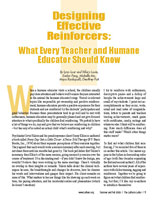Designing Effective Reinforcers: What Every Teacher and Humane Educator Should Know begins this way:
"When a humane educator visits a school, the children usually pay close attention and behave well because they are interested in the animal the humane educator brings. Versed in relevant topics like responsible pet ownership and positive reinforcement, humane educators provide a positive experience for their students and are reinforced by the students' participation and good behavior. Because these presentations tend to go well and be met with enthusiasm, humane educators may be generally pleased and not give focused attention to what specifically the children find reinforcing. We probably have a list of things we do, say and give that we believe are reinforcing to children—but has any of us asked an actual child what's reinforcing and why?"
Click here to read the full article.
Two of the child co-authors of Lynn Loar's piece, Hilary Louie and Evelyn Pang, created a related brochure entitled Teaching with a Clicker: How to Train People and Animals with a Clicker and Treats. Another brochure, Tagging: A New Way to Learn to Skate, was created by Michelle Ma and Maya Rankupalli, also co-authors with Lynn. Their brochure was adapted with permission from Teaching with a Clicker by Hilary Louie and Evelyn Pang.
Lynn says, "I think the kids did a great job, and I would love more people to read the brochures." Each brochure is excerpted below.
From Teaching with a Clicker: How to Train People and Animals with a Clicker and Treats by Hilary Louie and Evelyn Pang:
What is Clicker Training?
Is your dog like mine was? Does he or she jump and bark when friends come to the door? Does he or she run away or pull on the leash? Would you like your dog to learn good behaviors and even tricks? Clicker training is a game you play with dogs and other animals—even people—to teach good behaviors. All you need is a clicker, some treats, and this brochure. You'll learn how to make learning fun. And you'll learn ways to say "yes" to your learner by clicking and giving treats for good behaviors while ignoring bad ones. If you learn what's in this brochure, you'll be able to train your pet yourself. To have fun with clicker training, read on!
How to click:
You need a clicker, something that makes a short sound, and some treats.
Make the short sound when you think the behavior is close to what you want.
Give a treat right after you click.
Click here to read the full brochure.
From Tagging: A New Way to Learn to Skate by Michelle Ma and Maya Rankupalli, adapted with permission from Teaching with a Clicker by Hilary Louie and Evelyn Pang.
Do you want to learn to skate and earn points at the same time? If so, tagging is for you. A tagger is something that makes a short sharp sound. Your coach tags when you get a move right or get close to it. The tag tells you that you got the move right and have earned a point. this will encourage you to do the move again.
Click here to read the full brochure.
| Attachment | Size |
|---|---|
| Clicker_Bro_Eng.pdf | 228.18 KB |
| Designing_Effective_Reinforcers_LL.pdf | 757.45 KB |
| TAGS_brochure_skate.pdf | 1.14 MB |





Post new comment